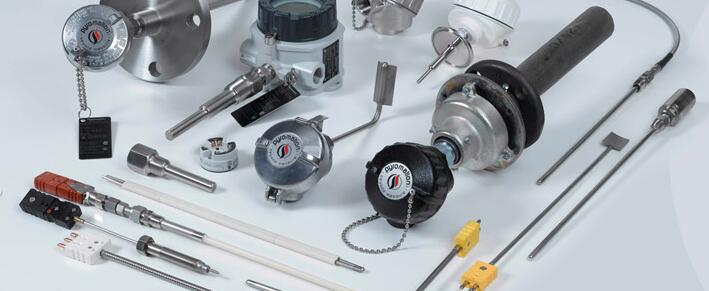
A thermocouple consists of a welded 'hot' junction between two dissimilar metals - usually wires - and a reference junction at the opposite end. The metal alloys chosen as thermocouple positive and negative leg wires define the type of thermocouple. Selection of the proper thermocouple type for a particular application is determined by temperature expectations and by the environment in which the sensor will be placed.
Popular generic and trade names for the most common thermocouple type wire combinations follow, as well as typical applications and limitations for each.
TYPE K THERMOCOUPLE
Alloy Combination: Chromel®/Alumel® Temp. Range: (0 to 1260) °C [32 to 2300] °F
Type K thermocouples are recommended for continuous oxidizing or neutral atmospheres and are mostly used above 538 °C [1000 °F]. They are subject to failure if exposed to sulphur. Preferential oxidation of chromium in positive leg at certain low oxygen concentrations causes 'green rot' and large negative calibration drifts most serious in the (816 to 1038) °C [1500 to 1900] °F range. Ventilation or inert-sealing of the protection tube can prevent these issues.
TYPE J THERMOCOUPLE
Alloy Combination: Iron/Constantan Temp. Range: (0 to 760) °C [32 to 1400] °F
The j type thermocouple is suitable for vacuum, reducing, or inert atmospheres, oxidizing atmosphere with reduced life. Iron oxidizes rapidly above 538 °C [1000 °F], so only heavy gauge wire is recommended for high temperature applications. Bare elements should not be exposed to sulphurous atmospheres above 538 °C [1000 °F].
TYPE T THERMOCOUPLE
Alloy Combination: Copper/Constantan Temp. Range: (-200 to 370) °C [-328 to 700] °F
Type T thermocouples can be used in oxidizing, reducing, or inert atmospheres as well as vacuum conditions. They are not subject to corrosion in moist atmospheres. See our catalog for Limits of Error published for sub-zero temperature ranges.
TYPE E THERMOCOUPLE
Alloy Combination: Chromel®/Constantan Temp. Range: (0 to 870) °C [32 to 1600] °F
Type E thermocouples are recommended for continuously oxidizing or inert atmospheres. Sub-zero limits of error are not established. This type has the highest thermoelectric output of common calibrations.
TYPE N THERMOCOUPLE
Alloy Combination: Nicrosil®/Nisil® Temp. Range: (0 to 1260) °C [32 to 2300] °F
Type N thermocouples can be used in applications where Type K elements have a shorter life and stability problems due to oxidation and the development of 'green rot'.
TYPE S THERMOCOUPLE & TYPE R THERMOCOUPLE
Type S Alloy Combination: Platinum/Platinum (10% Rhodium)
Type R Alloy Combination: Platinum/Platinum (13% Rhodium)
Temp. Range: (538 to 1481) °C [1000 to 2700] °F
Type S and Type R thermocouples are obviously very similar. They are both recommended for high temperature applications and must be protected with a non-metallic protection tube and ceramic insulators. Continued high temperature usage causes grain growth, which can lead to mechanical failure. Negative calibration drift can be caused by Rhodium diffusion to the pure leg as well as from Rhodium volatilization. The type R thermocouple is used in industry whereas type S is used in the laboratory.
TYPE B THERMOCOUPLE
Alloy Combination: Platinum (6% Rhodium)/Platinum (30% Rhodium)
Temp. Range: (871 to 1704) °C [1600 to 3100] °F
The type B thermocouple is very similar to type R and type S, but the output is lower. It is also less susceptible to grain growth and drift.
Looking for thermocouple assemblies by style? See our Thermocouples page.
Looking for exact specifications? See our catalog.
Chromel and Alumel are registered trademarks of Hoskins Mfg. Co.
Nicrosil and Nisil are registered trademarks of Amax Specialty Metals Corp.











